Growing jackfruit in South Florida? You bet!
If you subscribe to my YouTube channel, you probably saw the video I posted last week on my friends Chuck and Sarah who are growing jackfruit in their South Florida front yard:
The tree is almost, but not quite, as beautiful as Sarah:
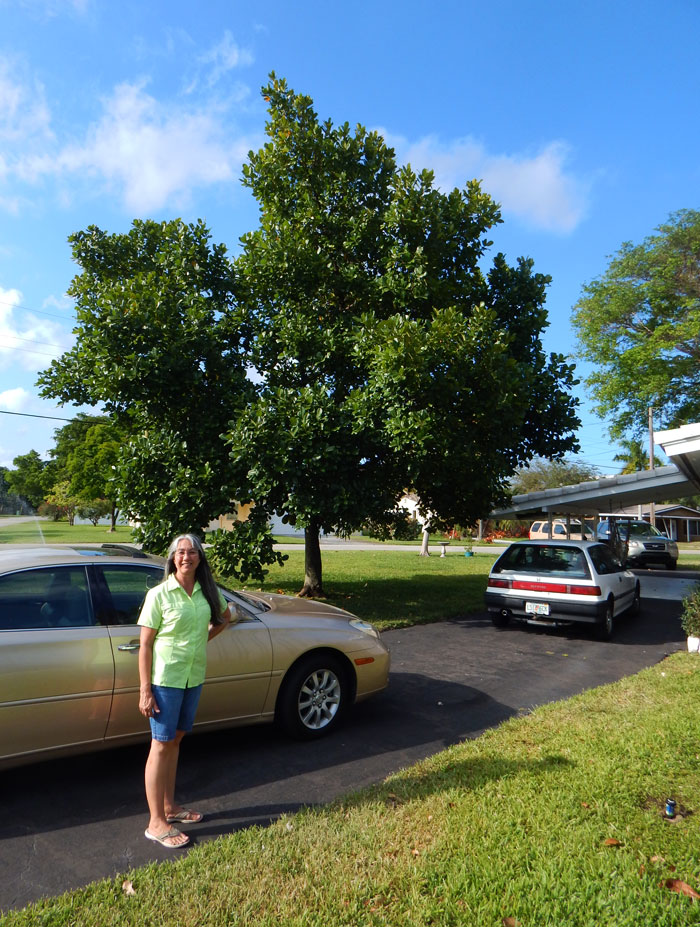
(She’s totally gonna kill me for saying that… fortunately I’m a zillion miles away from South Florida right now. Ha ha! Come and get me!)
This particular jackfruit tree is a truly magnificent specimen, loaded with highly valuable fruit.
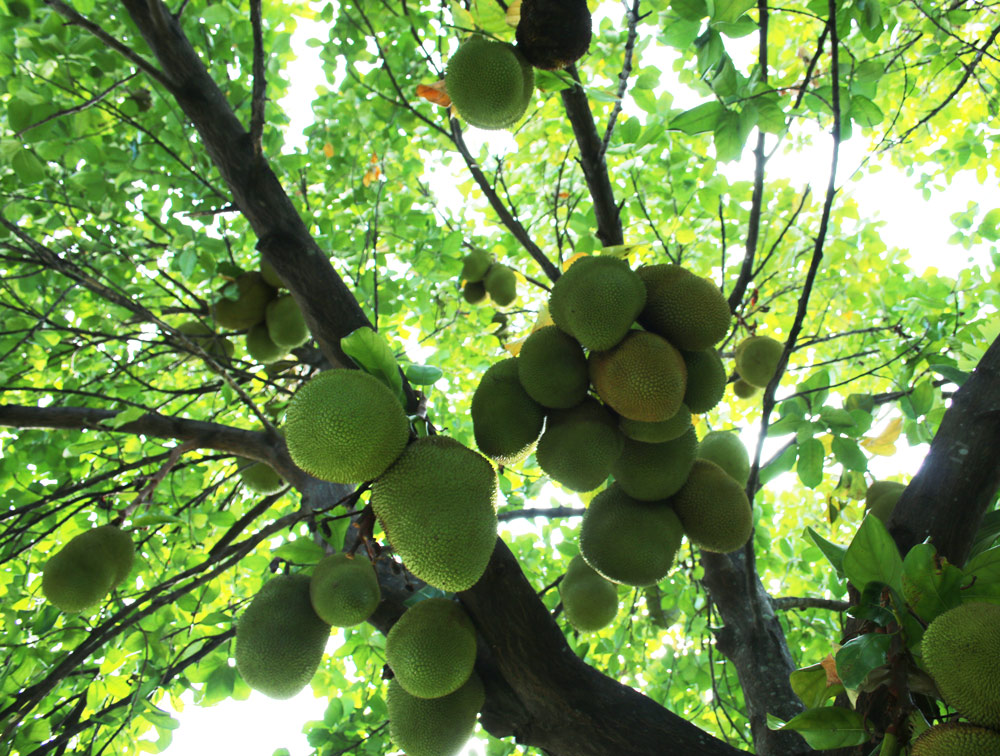
Can A Jackfruit Tree Handle Freezing?
A mature jackfruit tree, though a tropical through and through, has the ability to survive temperatures into the upper 20s for brief periods. That means you can grow them along the coast up into the Palm Beach area, with special care given to the trees when young.
“Jackfruit leaves may be damaged at 32°F (0°C), branches at 30°F (-1°C), and branches and trees may be killed at 28°(-2°C)”
I wanted to plant a jackfruit in The Great South Florida Food Forest Project, and in fact I did put a seedling in there at one point… but after seeing the size of Chuck and Sarah’s tree, Mom vetoed the idea. And the seedling DIED MYSTERIOUSLY
That little yard would be great with a massive tree canopy and gigantic fruits no one in the house would eat, don’t you think? C’mon, Mom!
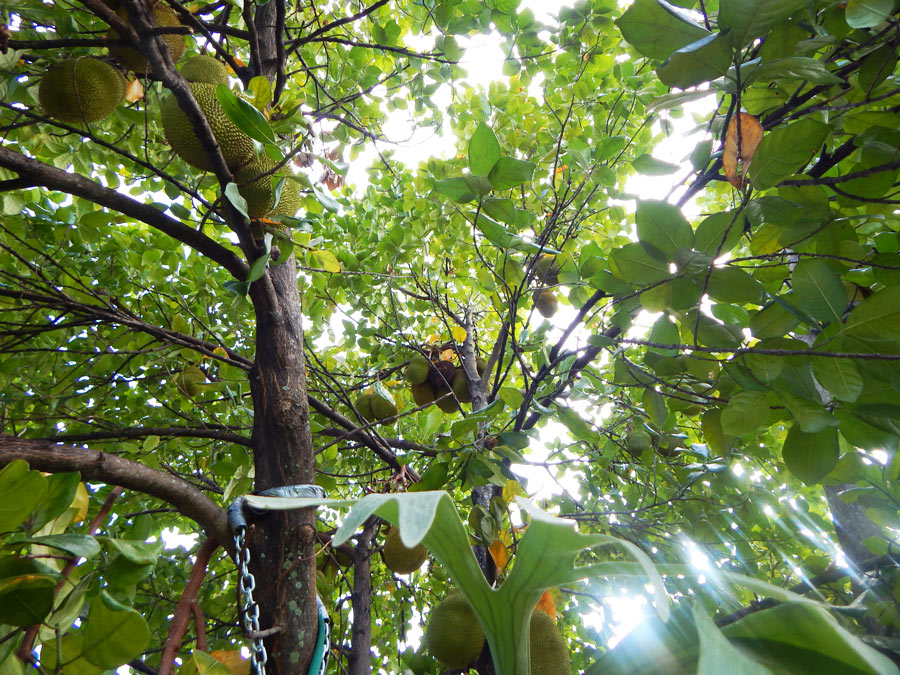
It’s just like another mulberry tree! You can never have enough mulberry trees!
Let me make the case further for those of you who, unlike my beloved mother, are on the fence about this beautiful tree.
Why You Should Grow a Jackfruit
If you’re way out of the range for growing jackfruit, as many of you are, then this article is just a curiosity… but if you’re in the range where they grow, or even close enough to zone-push a bit, let me make the case for this marvelous tree.
Where I now live in the Central American rainforest, jackfruit is well-known by many as a healthy, easy-to-grow delicacy that acts as a starch crop, a fruit crop, and a nut.
In the USA, it’s more of a “eww…. that’s weird…” kind of a fruit. This attitude isn’t helped by the fruit’s strange smell when ripe.
Let’s get the couple of negatives out of the way first.
Some has described the smell of ripe jackfruit as “boiled onions”; however, not all the jackfruit I’ve encountered smell like that. Some just smell somewhat fruity. Fortunately, once opened, there’s no strange scent to the delicious flesh inside.
Another objection to growing jackfruit trees in South Florida or elsewhere in the US is that most people have never tried them and are afraid of growing something they haven’t tasted.
That’s a sissy excuse. Just go for it. Sissy.
A final reason people don’t like jackfruit is the incredibly sticky latex in the rind and around the edible portions of the fruit. I’ve shown some pictures of us butchering a jackfruit before, laid out in a horror-movie style without any explanation.
…anyhow, here are some good reasons to grow jackfruit.
Reason #1: Jackfruit Trees are Beautiful
Look at this:
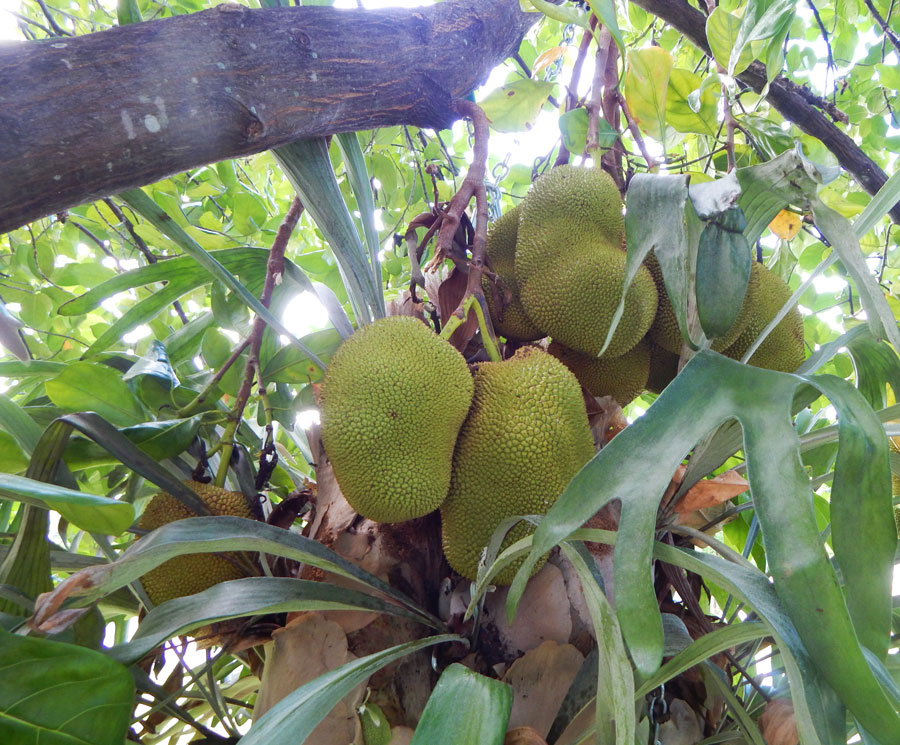
Jackfruit growing into a staghorn fern. Just that picture should be enough to make any gardener say “sign me up!” Plus, the fruits look like fractal geometry up close:
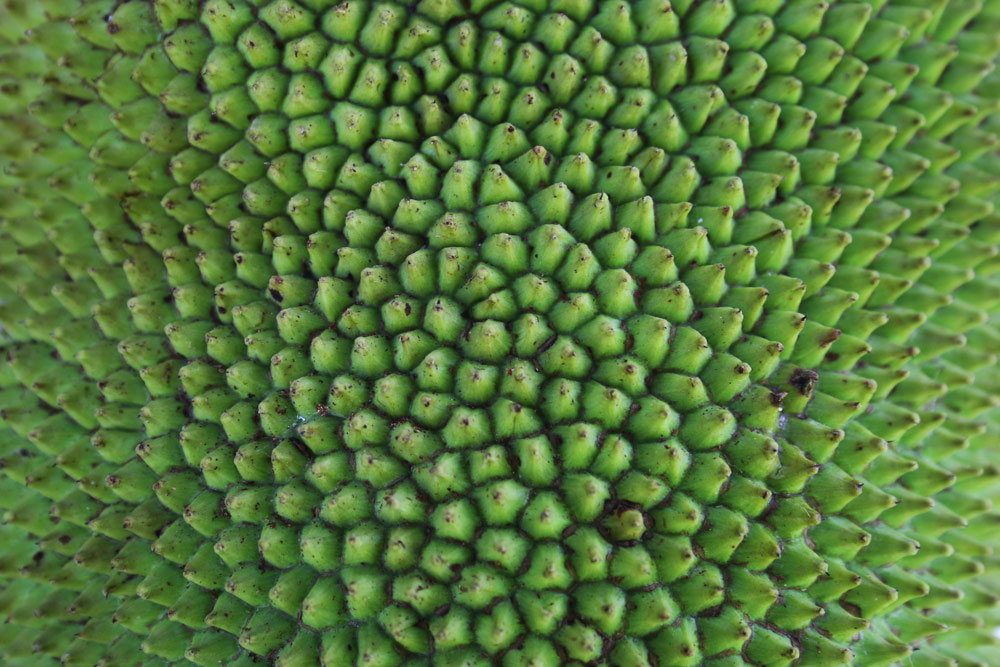
Not enough? How about some cold, hard capitalism?
Reason #2: Jackfruits are Highly Valuable
In the right ethnic markets, you can get mad money for good jackfruit. I’ve heard of them selling for $10 per LB! That’s pretty awesome, considering how many pounds one of these fruit can reach. Even if you never ate a single fruit yourself, you could likely cover one bill per month just selling jackfruit. A lot of immigrants miss the jackfruit of their home countries and don’t have the space or the time to grow their own. Meet the need and PROFIT!
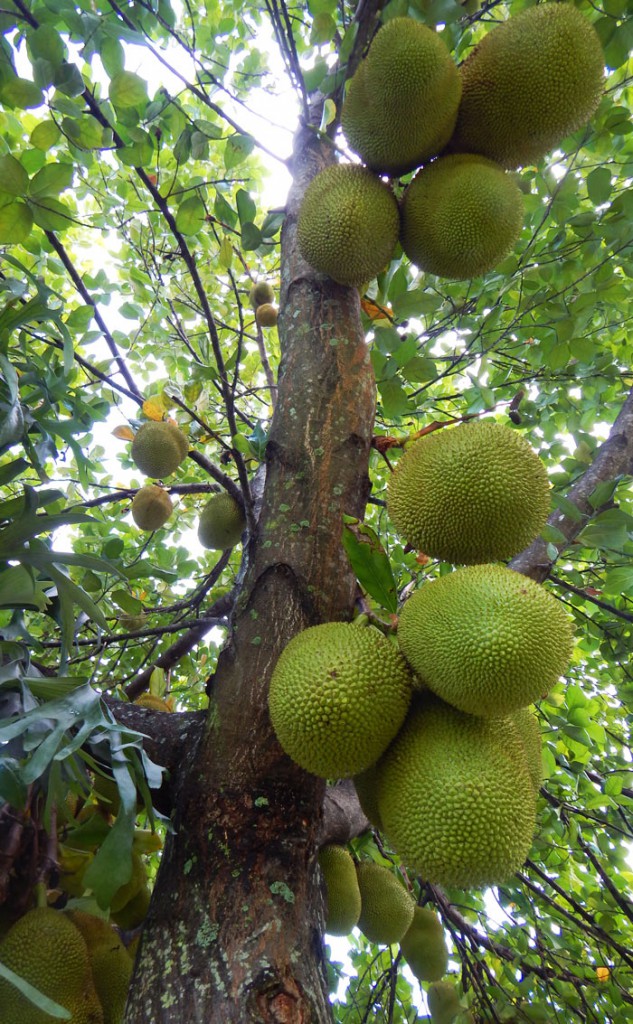
This is what mad money looks like
Reason #3: Jackfruit are Productive
Jackfruit trees can produce hundreds of pounds of fruit per yearand they will produce for about half the year… and sometimes will have ripening fruit here and there year-round. This productivity happens with very little care. Jackfruit can even start fruiting from seed under ideal conditions in just a couple of years.
My friend Chuck harvested about a dozen just when I was visiting their home to record my video:
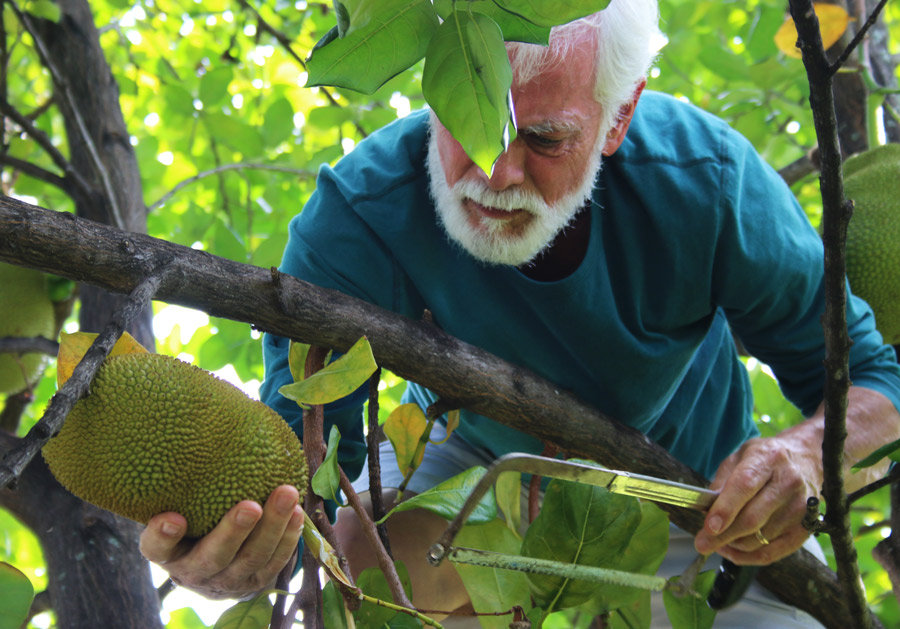
That was probably 140lbs worth… with easily another 1,000,000,000 LBS ON THE TREE!
Reason #4: Jackfruit are Delicious
You know Juicy Fruit(TM) gum? That flavor was based on jackfruit. The story goes that the owner of Wrigley’s gum tried a jackfruit and was blown away, so he took a fruit to his lab guys and said “make gum that tastes like this!”
The flavor of jackfruit is eminently tropical with undertones of passionfruit, pineapple and guava. It’s amazing. I can’t imagine anyone not liking it.
Reason #5: Jackfruit is also a Starch and a “Nut”
The seeds of a jackfruit can be boiled and eaten like chestnuts or boiled peanuts – and, like its close cousin the breadfruit, an entire unripe jackfruit can be skinned and roasted as a starchy vegetable. It’s not just a sweet fruit – it’s also a potential staple starch crop!
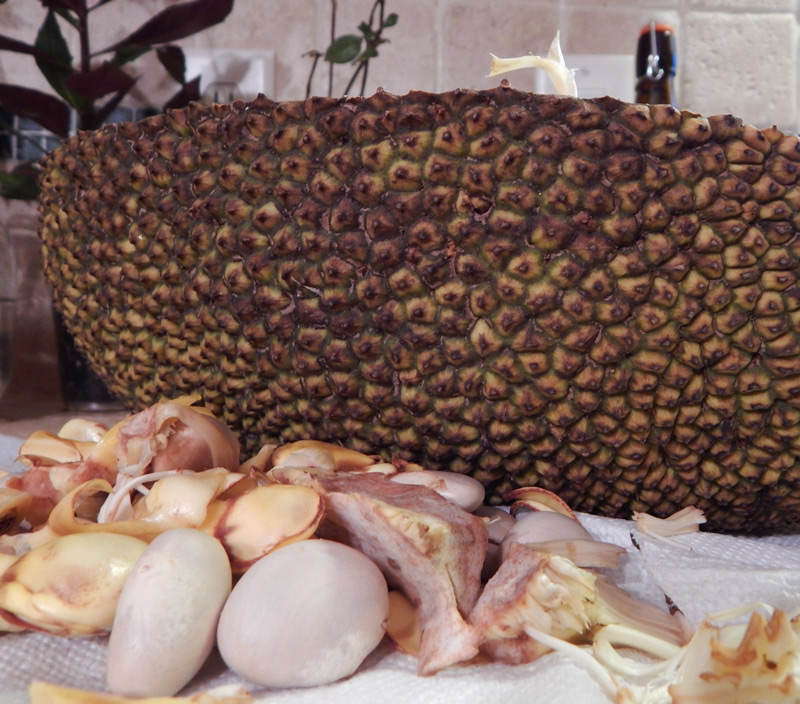
Edible “nuts” in the foreground, tasty fruit in the background.
Conclusion
If you can grow a jackfruit tree, do it. Even if you never ate a single fruit, you’d be the wonder of your neighborhood.

Growing Jackfruit in South Florida: Front Yard Edition!
Check and Sarah’s tree is quite a looker – and they had no idea what the tree was going to be like when mature. They went out on a limb (heheh) and now are harvesting huge fruits they can share with friends or sell at local markets. Growing jackfruit in South Florida (or other tropical regions) is delicious, fun and potentially profitable.
Why not go for it?

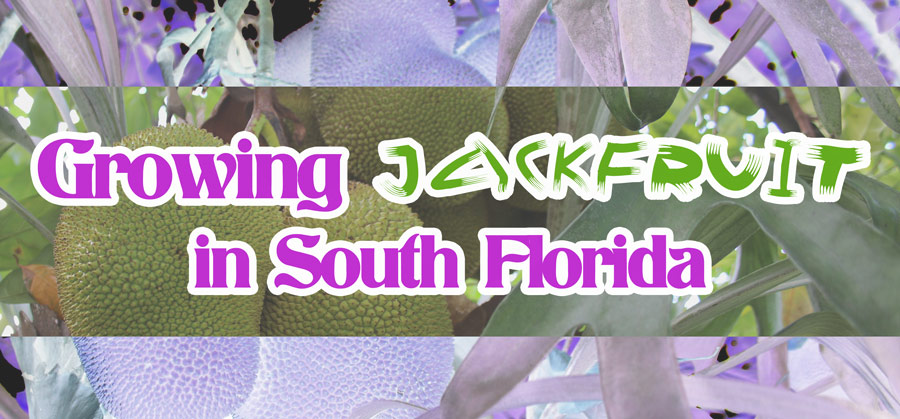
16 comments
Hey Mr. Goodman (David),
I would love to have one. I have the room for it . The problem is I am in Deland. We sometimes have below freezing weather… a few days out of the year. Would it be possible to prune it so it does not get to large to some how cover it during these times… or am I just dreaming the impossible dream?
Keith
I would totally try it. Plant a bunch of seeds and see which ones live, perhaps. Deland is pretty far up there and those cold snaps can be nasty… do it anyway. When the tree gets big it will tolerate the cold a lot better.
Hey David – I recently discovered your website, and am thoroughly enjoying the reading! This was a very interesting article; as you say, more of a curiosity for me as I’m in Mobile, AL, but informative nonetheless. Thanks!
Rob
Thank you, Rob.
I just discovered that the Indian grocery store here in Gainesville apparently carries this fruit routinely – both green whole fruits and sections of ripe ones. I wasn’t quite brave enough to try it today – the Atulfo mangos jumped in my basket instead – but I’ll pick some up soon. Thanks for the info – it looks mysterious and rather off-putting if you don’t know what you’re looking at.
You need to find a friend and make a terrifyingly serious pact to taste it together.
I’ve found mangoes have a way of jumping in when you don’t expect them, ruining all plans.
What is the name of the Indian grocery store that you found the jack fruit in? I’m looking for it . Please? Thank you
I’m not sure where it was, unfortunately.
Dude!
Been watching your videos and reading your website for awhile now.
I grow food here in south florida — I relate to your approach and love that you’re sharing the good word!
I brew my own compost tea for raised bed gardens that I manage. I also use sheet-mulching (with seaweed, coffee grinds, straw – I love straw, compost, pigeon pea leaves, etc etc)!
My buddy is making his own bio-char too and doing a black soldier fly composter.
If you’re ever in the area i’d love to show you my little food forest.
I loved this article on jackfruit. I recently introduced my Grandma (in Ohio) to the fruit. She got to try a little piece thanks to a super sweet gentleman at Kroger. She was sorta impressed…. but not as enthusiastic about it as I am!
I wrote a little article on growing jackfruit, check it out here….
http://www.alygrowsfood.com/articles/2015/8/3/jackfruit-tacos
Thanks again for doing the deal!!
This week I’m planting long red beans and a TON of turmeric. Stoked!
Aly, I’m glad you found me. We seem to be kindred spirits, or at least kindred plant geeks.
My parents live in South Florida and I was just there last month. If I make it back there I’ll look you up. I’ve left the state and now live in the middle of nowhere somewhere near the equator.
Your article on jackfruit was excellent. I’m going to link to it.
FYI, the word “articles” is spelled incorrectly on the sidebar of your site, unless “artciles” are a fruit I’m unfamiliar with. In that case, don’t tell me. I’d rather assume you can’t spell “articles” than know there’s a fruit out there I didn’t know about yet.
David, Im just now replying to this. I laughed out loud at your comment! I love/hate discovering new fruits I don’t know about. But mostly, I love it! I want to taste every fruit in the world. I may or may not have a checklist going…. (#fruitnerd)…
I corrected the spelling error on my website: thanks so much for catching that!
Wishing you well on your new journey. I’ve been loving the videos. It’s inspiring me to maybe make one myself.
With love,
Aly
Knock it out, Aly. If you post a good video, I’ll plug it here.
OH, and if you are in the area, I’ll hook you up with cuttings to see what kind of magic you can do up north. :)
David, I am glad I found you. I planted a jackfruit tree and it started to fruit but, the fruits were at the tip of the limbs and they got black when they were very small and fell off. I thought the fruits grew on the trunk of the tree. Now I see from your pictures that can grow elsewhere on the tree. What can I do to prevent them becoming black and which is the sweetest jackfruit I can plant.
Hi Barbara. Welcome!
Those “fruits” were just male blooms. The tree is probably still young. Just wait a little and see what happens, plus, keep it watered and well-fed.
I’m not sure which variety is the sweetest.
[…] The trees bear abundantly and require little care to cover you in Jackfruit. Even in South Florida, somewhat outside their normal range, jackfruit can do excellently – as my friends Chuck and Sarah can attest. […]
Comments are closed.